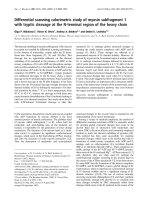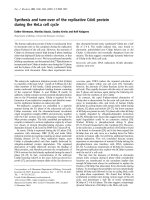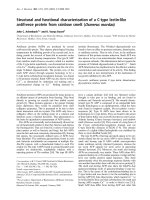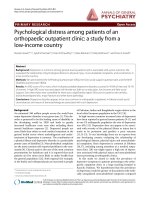Báo cáo y học: " ytotoxic T cell recognition of an HIV-1 reverse transcriptase variant peptide incorporating the K103N drug resistance mutation" pot
Bạn đang xem bản rút gọn của tài liệu. Xem và tải ngay bản đầy đủ của tài liệu tại đây (258.42 KB, 4 trang )
BioMed Central
Page 1 of 4
(page number not for citation purposes)
AIDS Research and Therapy
Open Access
Short report
Cytotoxic T cell recognition of an HIV-1 reverse transcriptase
variant peptide incorporating the K103N drug resistance mutation
Lisa Mahnke*
1
and David Clifford
2
Address:
1
Department of Medicine, Washington University School of Medicine, Saint Louis, USA and
2
Departments of Neurology and Medicine,
Washington University School of Medicine, Saint Louis, Missouri, USA
Email: Lisa Mahnke* - ; David Clifford -
* Corresponding author
Abstract
During HIV-1 infection, cytotoxic T cell (CTL) responses exert strong selective pressure on the
replicating virus population. Here we report evidence for T cell activity against the drug resistant
K103N region of viral reverse transcriptase in three HIV-1 infected patients exposed to NNRTI
antiretroviral drugs. We further characterize the response in one patient by ELISPOT analysis. A
nine amino acid peptide incorporating 103N was recognized by patient T cells whereas the wild
type was not. The RT K103N mutation is selected by the NNRTI class of HIV drugs. We
hypothesize that, in certain individuals, CTL responses against 103N-containing epitopes may
protect against NNRTI drug resistance. Characterizing such responses in the context of HLA
subtypes could lead to tailored HIV drug therapy or to the design of therapeutic vaccines.
Findings
During HIV-1 infection, anti-viral CTL responses develop
and persist [1,2]. Unfortunately, CTL escape mutations are
selected, helping the virus evade immune surveillance [3-
5]. Almost every region of the HIV proteome can serve as
a CTL target, including RT [6]. However, individual class I
HLA alleles restrict 8–10 amino acid epitopes such that
individuals vary in CTL epitope usage [8].
A few studies have demonstrated CTL responses directed
against HIV drug resistance mutations. An HLA-A2-
restricted RT epitope including the lamivudine-associated
M184V mutation has been characterized [9]. In another
study, epitopes incorporating M41L, L74V, M184V and
T215Y in RT were demonstrated by ELISPOT [10]. Finally,
Karlsson and colleagues have shown that a drug-resistant
mutant region in HIV protease can be a CTL target [11].
These studies suggest a dynamic interaction between anti-
viral immune responses and the selection of drug resist-
ance mutations during therapy.
The K103N mutation is a common cause of RT NNRTI
drug resistance. Clinically, this mutation is potent as a sin-
gle mutation and causes cross resistance to drugs in this
class [12]. We hypothesized that certain individuals can
mount T cell responses against epitopes incorporating
103N. If true, then individuals lacking such responses
might be predisposed to developing drug resistance at this
site.
We recruited 10 patients, 6 men and 4 women, chroni-
cally infected with HIV-1 who were exposed to the NNRTI
drug efavirenz. The study was approved by the Washing-
ton University Human Studies Committee, Study #04-
1207. All patients had recent negative serology for hepati-
tis C and were without fever. Blood samples were drawn
after informed consent was obtained. Subjects ranged in
Published: 14 September 2006
AIDS Research and Therapy 2006, 3:21 doi:10.1186/1742-6405-3-21
Received: 16 June 2006
Accepted: 14 September 2006
This article is available from: />© 2006 Mahnke and Clifford; licensee BioMed Central Ltd.
This is an Open Access article distributed under the terms of the Creative Commons Attribution License ( />),
which permits unrestricted use, distribution, and reproduction in any medium, provided the original work is properly cited.
AIDS Research and Therapy 2006, 3:21 />Page 2 of 4
(page number not for citation purposes)
age from 30–60 years old with CD4 counts between 334–
786 × 10
3
cells/ml. 9 had undetectable HIV RNA levels
(less than 40 copies/ml) by the Roche Amplicor assay
(Roche Diagnostics) within the last 6 months and had no
evidence of K103N on a standard HIV genotype (Quest
Diagnostics) within the last 5 years. The tenth, subject 2,
had a recent viral load of 2,000 copies/ml on a non-
NNRTI based regimen and had evidence of circulating
K103N by genotype 8 months prior to the study.
A second sample was drawn for subject 6705A 12 months
after the initial blood draw. Subject 6705A is a 30 year old
African American woman diagnosed with HIV in 2002.
She initiated a regimen of lamivudine, AZT and efavirenz
in October of 2004, at which time a viral load was 34,600
copies/ml with a CD4 count of 230 × 10
3
cells/ml. Within
two weeks she developed severe nausea and vomiting.
One week later, ectopic pregnancy was discovered requir-
ing surgery and withholding of antiviral medications. She
restarted therapy but continued to miss doses. As of
December, 2004, and April, 2005, the viral loads
remained less than 150 copies/ml, increasing to a range of
1,000–2,000 copies/ml by April and May, 2004. In
November 2005, K103N was detected on a standard gen-
otype, at which time the viral load was 5,100 copies/ml.
Peptides were designed based on published sequences
[13] and known consensus drug resistance mutations.
Peptides were synthesized by Sigma Genosys (The Wood-
lands, TX) at 96–99% purity as follows: KKK
KSVTVL,
KKN
KSVTVL, HPAGLKKKK, HPAGLKKNK, LGIPH-
PAGLKKN
KSVTVL, GLKKNKSVTVLDVGDAYF, GLKKKKS-
VTVLDVGDAYF with the underlined residue representing
position 103 in RT. The control peptide was AASIRLRPG-
GKASASA. Stock solutions were made by resuspending
peptides in water or acidic solution as recommended by
the manufacturer; all peptides were soluble. Peptides were
designed using Peptgen [14] for maximal MHC binding
prediction.
PBMC were isolated from the peripheral blood on Ficoll-
Hypaque (Sigma, St. Louis, MO) by centrifugation. PBMC
were plated on IFN-γ-coated 96 well plates (Endogen,
Rockford, IL) at a density of 1 × 10
5
cells per well using
RPMI 1640 media with glutamine supplementation
(Sigma, St. Louis, MO) and 10% fetal calf serum. The pep-
tide stocks were diluted in RPMI media and added to the
wells at a final concentration of 14 μg/ml each. 5 μg/ml
PHA (Sigma, St. Louis, MO) was used as a stimulant con-
trol. The plates were incubated 24 hours at 37°C, 5% CO
2
and developed according to the manufacturer's instruc-
tions. Briefly, the plates were washed then incubated with
INF-γ detection antibody (Endogen). After washing, plates
were incubated with streptavidin-AP conjugate secondary
antibody (Endogen). After a final washing, NBT/BCIP
substrate (Endogen) was added and the color was devel-
oped. Spots were counted manually using a dissection
microscope. In the initial screen, wells were considered
positive if total counts were greater than 10 spots per well.
Recombinant IFN-γ controls produced intense staining;
PHA control showed innumerable spots; media-only con-
trol produced less than 3 spots per well (data not shown).
For subject 6705A, the month 12 blood sample was ana-
lyzed by ELISPOT by plating PBMCs 1.3 × 10
5
or 5 × 10
4
per well in triplicate. HLA class I typing on whole blood
or PBMC fraction genomic DNA was performed at the
Washington University School of Medicine HLA labora-
tory using a commercial assay (Invitrogen) using PCR and
HLA-specific probe hybridization.
Results of class I typing are as follows [subject) HLA-A,
HLA-B, HLA-C]: 4A) A03/25, B18/35, Cw04/12; 52405A)
A02/*, B07/15, Cw03/15; 52605) A02/24, B35/40,
Cw03/04; 6105) A03/*, B50/57, Cw07/18; 6205A) A11/
30, B42/52, Cw12/17; 6205B) A02/24, B07/27, Cw01/07;
6605B) A02/03, B07/44, Cw05/07; 6605C) A02/*, B18/
57, Cw06/07; 6705A) A23/33, B15/58, Cw02/03; 2) A03/
23, B35/37, Cw02/07 (*represents likely homozygosity as
common A02 or A03 alleles but a rare second allele can-
not be excluded).
The IFN-γ ELISPOT assay is known to correlate with
cytokine flow cytometry-based methods and is a sensitive
test for antigen-specific T cell activity [15]. By this method,
we found the region around mutation K103N to be reac-
tive to T cells in 3 of the 10 subjects using 18-mer 103N
mutant peptides in an initial screen. Subjects 6205A and
6705A had significant responses to a mixture of LGIPH-
PAGLKKN
KSVTVL plus GLKKNKSVTVLDVGDAYF (pep-
tides assayed together). Subject 2 had a significant
response to GLKKN
KSVTVLDVGDAYF and a response
slightly above background for LGIPHPAGLKKN
KSVTVL
(data not shown).
We next verified and characterized an epitope incorporat-
ing K103N in subject 6705A using PBMCs obtained 12
months after the initial ELISPOT assay. As shown in Figure
1, individual 18-mer mutant peptides LGIPH-
PAGLKKN
KSVTVL and GLKKNKSVTVLDVGDAYF reacted
with the subject's T cells, confirming the previous mixed-
peptide result. Wild type peptide GLKKK
KSVTVLDVG-
DAYF did not react. Furthermore, a 9-mer mutant peptide,
KKN
KSVTVL, reacted significantly whereas the wild type
did not (Fig. 1). Finally, neither mutant nor wild type 9-
mers HPAGLKK(N/K)K displayed CTL activity (Fig. 1).
These results indicate that subject 6705A was able to
mount an anti-103N CTL response if 103N was properly
positioned within the epitope. The reactivity of such a
short peptide suggests that the response is due to CTL
activity [8].
AIDS Research and Therapy 2006, 3:21 />Page 3 of 4
(page number not for citation purposes)
If HLA A or B is important for the 103N antiviral response
at RT amino acids 101–109 in subject 6705A, then candi-
date alleles for presentation of this peptide are A23, A33,
B15 or B58. Although the alleles were typed only to two
digits in this study, among A*2301, A*3301, B*1501 and
B*5801, A*2301 can be predicted to have the highest
binding affinity for KKN
KSVTVL at a predicted IC50 of
613 nM using an smm prediction tool [16,17]. It is inter-
esting to note that subject 2 also carries an A23 allele and
demonstrated responses against this region.
Because of the relatively long half life of efavirenz,
patients who simultaneously discontinue combination
antiretroviral therapy are exposed to functional efavirenz
monotherapy [18]. Such monotherapy can result in the
rapid selection of K103N [19]. For subject 6705A, anti-
103N CTL activity may have contributed to suppression of
103N mutant virus replication, as reflected by the rela-
tively low levels of viremia prior to switching drug ther-
apy.
The emergence of K103N and other drug resistant variants
may be a dynamic process influenced by patient-specific
anti-HIV CTL activity. In support of this idea, interactions
between certain HLA subtypes, specific antiretroviral drug
exposures and HIV sequence diversity have been found
[20]. Another study found CTL responses against drug
resistant variants [21] but did not assess the RT 103 region
that we describe here. Characterizing more HLA subtypes
with regard to HIV epitopes incorporating drug resistance
mutations could lead to the design of therapeutic vaccines
or suggest tailored therapy against HIV.
Competing interests
The author(s) declare that they have no competing inter-
ests.
Abbreviations
HIV: human immunodeficiency virus. HLA: human lym-
phocyte antigen. CTL: cytotoxic T cell lymphocyte. RT:
reverse transcriptase. MHC: major histocompatibility
complex. NRTI: nucleoside reverse transcriptase inhibitor.
ELISPOT: enzyme-linked spot assay. NNRTI: non-nucleo-
side reverse transcriptase inhibitor. PBMC: peripheral
blood mononuclear cells. IFN-γ: interferon gamma. PHA:
phytohemagglutinin.
Authors' contributions
LM conceived of the study, designed the protocol,
obtained institutional review board approval, collected
and processed samples, performed immunoassays and
analyzed the results. DC assisted in study design and data
analysis. Both authors read and approved the final manu-
script.
ELISPOT assay for CTL responses to RT 103 region peptidesFigure 1
ELISPOT assay for CTL responses to RT 103 region peptides. Subject 6705A PBMCs were stimulated with wild type
or mutant peptides as described in the text. RT position 103 is underlined. Error bars indicate standard deviations of assays
performed in triplicate.
Publish with BioMed Central and every
scientist can read your work free of charge
"BioMed Central will be the most significant development for
disseminating the results of biomedical research in our lifetime."
Sir Paul Nurse, Cancer Research UK
Your research papers will be:
available free of charge to the entire biomedical community
peer reviewed and published immediately upon acceptance
cited in PubMed and archived on PubMed Central
yours — you keep the copyright
Submit your manuscript here:
/>BioMedcentral
AIDS Research and Therapy 2006, 3:21 />Page 4 of 4
(page number not for citation purposes)
Acknowledgements
The authors thank Lisa Kessels and Michael Klebert for assistance with
patient enrollment and sample collection, Nancy Campbell for technical
assistance, and the Washington University AIDS Clinical Trials Unit for
assistance. We thank Brian Duffy for HLA typing and Dr. Thalachallour
Mohanakumar, Washington University Department of Surgery, for helpful
discussion. This work was funded by a Virology Fellows Program grant from
Bristol-Myers Squibb, Co. (LM).
References
1. Walker BD, Charkrabarti S, Moss B, Paradis TJ, Flynn T, Durno AG,
Blumberg RS, Kaplan JC, Hirsch MS, Schooley RT: HIV-specific
cytotoxic T lymphocytes in seropositive individuals. Nature
1987, 328:345-382.
2. Draenert R, Verrill CL, Tang Y, Allen TM, Wurcel AG, Boczanowski
M, Lechner A, Kim AY, Suscovich T, Brown NV, Addo MM, Walker
BD: Persistent recognition of autologous virus by high-avidity
CD8 T cells in chronic, progressive human immunodefi-
ciency virus type 1 infection. J Virol 2004, 78:630-41.
3. Allen TM, O'Connor DH, Jing P, Dzuris JL, Mothe BR, Vogel TU, Dun-
phy E, Liebl ME, Emerson C, Wilson N, Kunstman KJ, Wang X, Allison
DB, Hughes AL, Desrosiers RC, Altman JD, Wolinsky SM, Sette A,
Watkins DI: Tat-specific cytotoxic T lymphocytes select for
SIV escape variants during resolution of primary viraemia.
Nature 2000, 407:386-90.
4. Goulder PJ, Brander C, Tang Y, Tremblay C, Colbert RA, Addo MM,
Rosenberg ES, Nguyen T, Allen R, Trocha A, Altfeld M, He S, Bunce
M, Funkhouser R, Pelton SI, Burchett SK, McIntosh K, Korber BT,
Walker BD: Evolution and transmission of stable CTL escape
mutations in HIV. Nature 2001, 412:334-338.
5. Kelleher AD, Long C, Holmes ED, Allen RL, Wilson J, Conlon C,
Workman C, Shanunak S, Olson K, Goulder P, Brander D, Ogg G,
Sullivan JS, Dyer W, Jones I, McMichael AJ, Rowland-Jones S, Phillips
RE: Clustered mutation in HIV-1 gag are consistently
required for escape from HLA-B27-restricted cytotoxic T
lymphocyte responses. J Exp Med 2001, 193:375-386.
6. Walker BD, Flexner C, Paradis TJ, Fuller TC, Hirsch MS, Schooley RT,
Moss B: HIV-1 reverse transcriptase is a target for cytotoxic
T lymphocytes in infected individuals. Science 1988, 240:64-6.
7. Altfeld M, Addo MM, Shankarappa R, Lee PK, Allen TM, Yu XG,
Rathod A, Harlow J, O'Sullivan K, Johnston MN, Goulder PJ, Mullins
JI, Rosenberg ES, Brander C, Korber B, Walker BD: Enhanced
detection of human immunodeficiency virus type 1-specific
T-cell responses to highly variable regions by using peptides
based on autologous virus sequences. J Virol 2003, 77:7330-40.
8. Rudolph MG, Stanfield RL, Wilson IA: How TCRs bind MHCs,
peptides, and coreceptors. Ann Review Immunol 2006,
24:419-466.
9. Schmitt M, Harrer E, Goldwich A, Bauerle M, Graedner I, Kalden JR,
Harrer T: Specific recognition of lamivudine-resistant HIV-1
by cytotoxic T lymphocytes. AIDS 2000, 14:643-8.
10. Samri A, Haas G, duntze J, Bouley JM, Calvez V, Katlama C, Autran B:
Immunogenicity of mutations induced by nucleoside reverse
transcriptase inhibitors for human immunodeficiency virus
type 1-specific cytotoxic T cells. J Virol 2000, 74:9306-9312.
11. Karlsson AC, Deeks SG, Barbour JD, Heiken BD, Younger SR, Hoh
R, Lane M, Sallberg M, Ortiz GM, Demarest JF, Leigler T, Grant RM,
Martin JN, Nixon DF: Dual pressure from antiretroviral ther-
apy and cell-mediated immune response on the human
immunodeficiency virus type 1 protease gene. J Virol 2003,
77:6743-6752.
12. Clavel F, Hance AJ: HIV drug resistance. NEJM 2004,
350:1023-1035.
13. Los Alamos National Laboratory HIV SequenceDatabase
[ />]
14. Los Alamos HIV Database, HIV Molecular Immunology
[ />]
15. Karlsson AC, Martin JN, Younger SR, Bredt BM, Epling L, Ronquillo R,
Varma A, Deeks SG, McCune JM, Nixon DG, Sinclair E: Comparison
of the ELISPOT and cytokine flow cytometry assays for the
enumeration of antigen-specific T cells. J Immunol Methods
2003, 283:141-153.
16. Immune Epitope Database and Analysis Resource [http://
www.immuneepitope.org]
17. Peters B, Sidney J, Bourne P, Bui HH, Buus S, Doh G, Fleri W, Kro-
nenberg M, Kubo R, Lund O, Nemazee D, Ponomarenko JV, Sathia-
murthy M, S choenberger S, Stewart S, Surko P, Way S, Wilson S,
Sette A: The immune epitope database and analysis resource:
from vision to blueprint. PLoS Biol 2005, 3:e91.
18. Ribaudo HJ, Hass DW, Tierney C, Kim RB, Wilkinson GR, Gulick RM,
Clifford DB, Marzolini C, Fletcher CV, Tashima KT, Kuritzkes DR,
Acosta EP: Pharmacogenetics of plaslma efavirenz exposure
after treatement discontinuation: an adult AIDS Clinical Tri-
als Group study. Clin Infect Dis 2006, 42:401-407.
19. Bacheler LT, Anton ED, Kudish P, Baker D, Bunville J, Krakowski K,
Bolling L, Aujay M, Wang XV, Ellis D, Becker MF, Laut AL, George HJ,
Spalding DR, Hollis G, Abremski K: Human immunodeficiency
virus type 1 mutations selected in patients failing efavirenz
combination therapy. Antimicrob Agents Chemother 2000,
44:2475-2484.
20. John M, Moore CB, James IR, Mallal SA: Interactive selective pres-
sures of HLA-restricted immune responses and antiretrovi-
ral drugs on HIV-1. Antivir Ther 2005, 10:551-555.
21. Mason RD, Bowmer MI, Howley CM, Gallant M, Myers JCE, Grant
MD: Antiretroviral drug resistance mutations sustain or
enhance CTL recognition of common HIV-1 Pol epitopes. J
Immunol 2004, 172:7212-7219.









